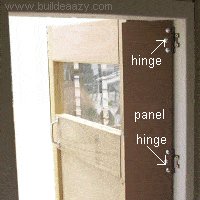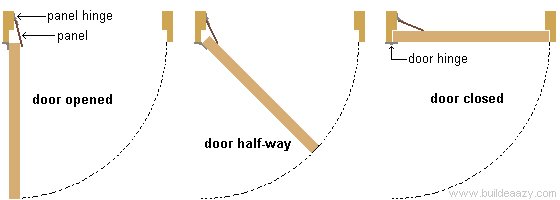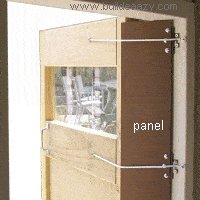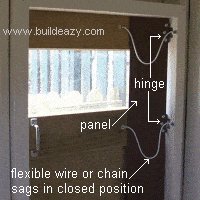![]() It is highly likely that most of us at some time or other in our growing up years have experienced the odd finger or two being jammed by a closing door or at least been instrumental in the causing of someone else’s finger to be caught.
It is highly likely that most of us at some time or other in our growing up years have experienced the odd finger or two being jammed by a closing door or at least been instrumental in the causing of someone else’s finger to be caught.
![]()
This particular door is likely to be more of a risk to little fingers than a normal house door because it is a lot narrower than a normal door making it easier for a child to reach the hinge side of the door, and also because the door is a playhouse door, it is always going to be surrounded by kids. Big kids should not be of concern, it is more for the little kids, crawlers and toddlers that may need a bit of “finger protection”.
How to help prevent fingers from being jammed in a closing door.
 1). The most likely hazard area
1). The most likely hazard area
The most likely area of a door to be of concern to a small child’s fingers is the hinge side of the door.
That is because only a little bit of force is needed to push the door shut but at the same time the hinge edge of the door closing in to the door jamb is of a far greater force. It is all to do with leverages, and even a moderate wind strong enough to move a door may cause injury to the unsuspecting toddler’s fingers that might be between the door hinge and jamb.
![]()
Possible solution? Cover the area of concern.
 2.) Cover the area
2.) Cover the area
2a.)Open the door wide out as far as it will go.
In this case we have put a post in the ground to stop the door from opening much more than at right angles (90 degrees) to the door way.
![]()
2b.) Cut a panel to cover the hinged edge of the door and the rebate in the adjacent jamb.
The panel can be a rigid plastic type material or wood about 4mm (3/16″) thick. The panel must be durable.
Make the panel wide enough to cover (run slightly past) the edge of the door and also to cover most of the jamb. You will be able to get a perspective by looking at the photos.
Make the panel high enough to sit between the door frame head and sill.
![]()
2c.) Fix three hinges to the panel, one at the top, one at the bottom and one in the middle.
Use bolts and nuts to secure the hinges to the panel (will require drilling bolt holes in the panel) as the panel is not thick enough to support screws.
Hold the panel in place and screw the free sides of the hinges to the jamb.

Use stretch curtain wire or similar to hold the panel against the door when the door is open. Stretch curtain wire can be obtained from just about any drapery store and eyes (screws with circular heads) can easily be screwed into the ends of the stretch curtain wire.


Screw the three pieces of stretch curtain wire in place as shown in the photos. There will be one piece at the top, one at the bottom and one in the middle.
Screw through the eyes of the screws in the curtain wire into the door and jamb.
Depending on the size of the screw head, washers may be required.
 All done!
All done!When the door shuts, the panel hinges will allow the panel to move with the door.
When the door is in the closed position, the stretch curtain wire will sag.
When the door opens, The stretch curtain wire will pull taut thus guiding the panel around and against the door.






